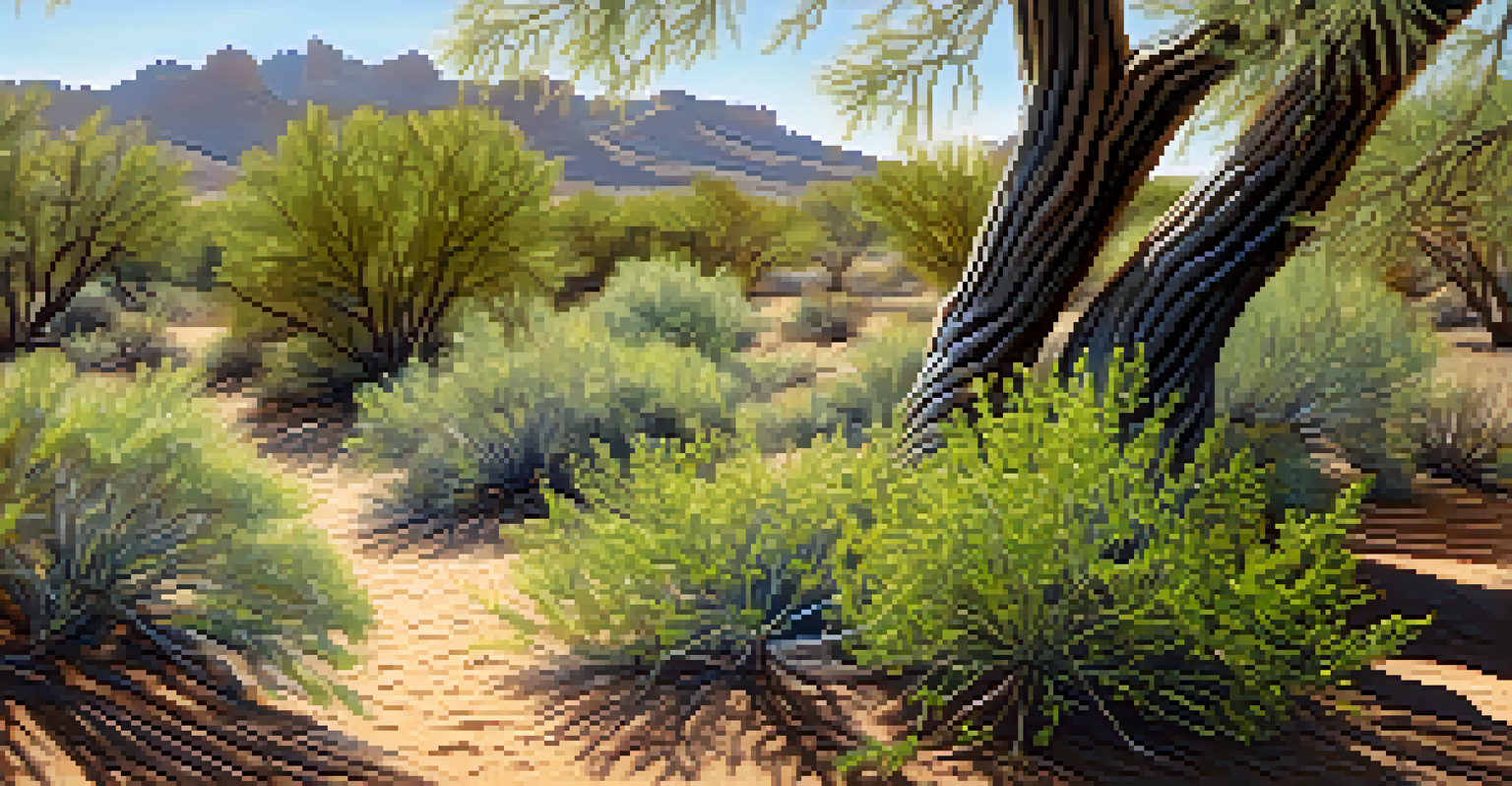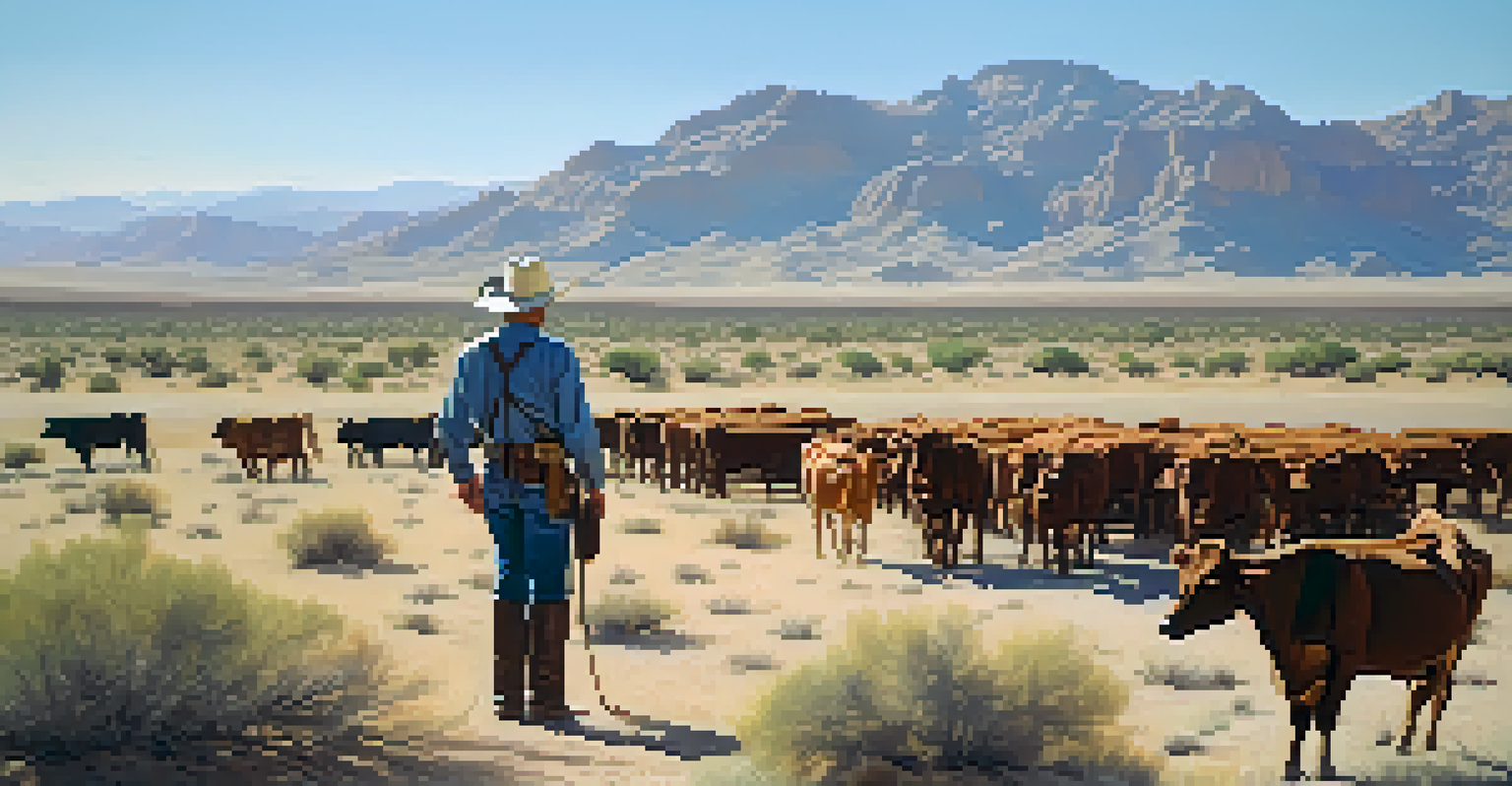Ranching Techniques Unique to Arizona's Desert Environment

Understanding Arizona's Unique Desert Environment
Arizona's desert landscape presents a unique set of challenges for ranchers. With its arid climate, extreme temperatures, and scarce water resources, traditional ranching methods may not suffice. Ranchers here must adapt their strategies to thrive in this harsh environment, ensuring that both livestock and land are sustainable.
The desert is a natural extension of our character; it holds both beauty and hardship, and in that duality, we find our strength.
The Sonoran Desert, which covers much of Arizona, is characterized by its diverse flora and fauna. This biodiversity plays a crucial role in ranching practices, as ranchers often rely on native plants for forage. Understanding the ecosystem allows ranchers to make informed decisions about grazing management, ensuring they don't overexert the land's resources.
Moreover, the desert's weather patterns, including monsoon rains, influence ranching practices. Ranchers must be well-versed in climate variability, allowing them to adjust their operations as needed. This adaptability is key to successful ranching in Arizona's unique environment.
Water Conservation Techniques in Ranching
Water is a precious commodity in Arizona's desert, prompting ranchers to implement innovative conservation techniques. For instance, many ranchers utilize rainwater harvesting systems to capture and store rainwater for livestock use. This not only ensures a steady water supply but also lessens the impact on local aquifers.

Another effective strategy is the use of water-efficient irrigation systems for growing feed crops. Techniques like drip irrigation minimize water waste and deliver moisture directly to the roots of the plants. This method not only conserves water but also promotes healthier crop yields, supporting livestock nutrition.
Sustainable Ranching Practices
Ranchers in Arizona utilize innovative methods, such as rotational grazing and native plants, to ensure the health of both livestock and the desert ecosystem.
Additionally, ranchers are increasingly using solar-powered water pumps to access groundwater. These pumps not only reduce energy costs but also provide a sustainable solution to water management in remote areas. By leveraging technology, Arizona ranchers are finding new ways to thrive in a challenging environment.
Grazing Management for Sustainability
Sustainable grazing management is essential for maintaining healthy rangelands in Arizona. Ranchers often employ rotational grazing, where livestock are moved between pastures to prevent overgrazing. This not only helps the land recover but also encourages the growth of native vegetation, which benefits both the ecosystem and the livestock.
Sustainability isn’t just about the environment; it’s about the economy and the community as well.
Another practice gaining traction is the use of herd diversity. By integrating different types of livestock, ranchers can better utilize the available forage and reduce the risk of disease. For instance, combining sheep and cattle can help manage vegetation more effectively, as each species grazes differently.
Furthermore, ranchers are increasingly incorporating technology to monitor grazing patterns and land health. Tools like GPS tracking and soil moisture sensors enable ranchers to make data-driven decisions, ensuring that their practices are both efficient and environmentally friendly. This holistic approach to grazing management fosters resilience in Arizona's delicate desert ecosystem.
Utilizing Native Plants for Forage
Incorporating native plants into ranching practices is a hallmark of Arizona's desert ranching. Many ranchers are discovering the benefits of planting drought-resistant species that thrive in arid conditions. These native plants not only provide essential forage for livestock but also enhance biodiversity on the ranch.
For example, species like mesquite and palo verde offer excellent nutrition for cattle while requiring minimal water. By relying on these plants, ranchers can significantly reduce their dependence on supplemental feed, which is often costly and resource-intensive. This shift not only benefits the ranch's bottom line but also promotes ecological balance.
Water Conservation is Key
With water scarcity in Arizona's desert, ranchers implement techniques like rainwater harvesting and solar-powered pumps to manage water resources efficiently.
Moreover, promoting native vegetation helps combat soil erosion and supports local wildlife. By fostering a healthy ecosystem, ranchers contribute to the overall resilience of Arizona's landscapes. This symbiotic relationship between ranching and native plants exemplifies a sustainable approach to agriculture in the desert.
Adapting to Climate Change in Ranching
Climate change poses significant challenges for ranchers in Arizona, necessitating innovative adaptations. Increased temperatures and changing precipitation patterns require ranchers to rethink their traditional practices. This awareness is prompting the adoption of more resilient farming techniques and diversified operations.
For instance, some ranchers are shifting their breeding programs to focus on livestock breeds that are better suited for hotter climates. Breeds like Brahman cattle are known for their heat tolerance and can thrive in Arizona's conditions. This strategic shift not only enhances animal welfare but also improves productivity in a warming world.
Additionally, ranchers are increasingly participating in conservation programs to protect their land and resources against climate impacts. Collaborating with environmental organizations, they implement practices that enhance soil health and water retention. This proactive approach not only safeguards their operations but also contributes to the overall health of Arizona's ecosystems.
Community and Collaboration Among Ranchers
Community plays a vital role in the success of ranching in Arizona's desert. Ranchers often come together to share knowledge, resources, and support. This sense of camaraderie fosters collaboration that can lead to innovative solutions to common challenges faced in the arid landscape.
For example, many ranchers form cooperatives to collectively purchase feed, equipment, or water rights. By pooling resources, they not only save money but also strengthen their bargaining power in the market. This spirit of cooperation enhances the sustainability of ranching operations across the region.
Community Drives Innovation
Collaboration among ranchers fosters resource sharing and education, enhancing sustainable practices and ensuring the longevity of ranching traditions in the region.
Moreover, community-driven initiatives focus on educating new ranchers about best practices tailored to Arizona's unique environment. Workshops and training sessions help equip them with the skills to manage their operations sustainably. This emphasis on community empowerment ensures that ranching traditions continue to thrive in the desert.
The Future of Ranching in Arizona's Desert
Looking ahead, the future of ranching in Arizona's desert is filled with potential and promise. Innovative techniques and sustainable practices are reshaping the landscape of agriculture, allowing ranchers to adapt to environmental challenges. As technology advances, ranchers are equipped with tools to optimize their operations while preserving the delicate desert ecosystem.
The growing focus on sustainable practices is also attracting a new generation of ranchers. Young entrepreneurs are eager to explore opportunities in regenerative agriculture, further contributing to the evolution of ranching in Arizona. Their fresh perspectives and commitment to sustainability are revitalizing the industry.

Ultimately, the resilience and adaptability of Arizona's ranchers will ensure that ranching continues to be a vital part of the state's heritage. By embracing both tradition and innovation, they are paving the way for a sustainable future in the desert.